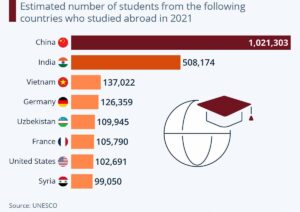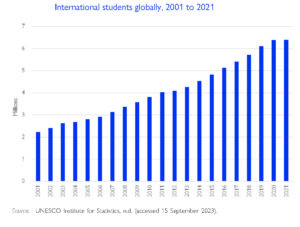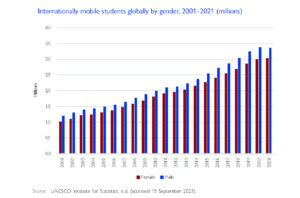The number of internationally mobile students globally has significantly increased over the last two decades, as highlighted by data collected by UNESCO.33 In 2001, this number was at just over 2.2 million. A decade later, the number of internationally mobile students had grown to more than 3.8 million. This number continued to increase in the following years, rising to over 6 million in 2021, nearly triple the figure 20 years prior. Despite the COVID-19 pandemic and related mobility restrictions, the number of internationally mobile students remained strong. Between 2020 and 2021 – at the height of the pandemic – the number of internationally mobile students increased slightly (from 6.38 million to 6.39 million), defying expectations.
Historically, the population of internationally mobile students has been gendered, with male students consistently outnumbering female students. In 2001, there were around 1 million internationally mobile female students (45% of the total) and 1.2 million male students (54%). While this gap has narrowed over the last 20 years, the number of internationally mobile female students remains lower than that of male students. In 2021, around 3 million internationally mobile students were female (47%) and males comprised around 3.4 million (52%).

Countries in Asia are the origins of the largest number of internationally mobile students in the world. In 2021, more than 1 million internationally mobile students were from China, by far the highest number globally and more than double the number of students from India, which ranks second (around 508,000). Other significant origin countries include Viet Nam, Germany and Uzbekistan (around 100,000 each), although their numbers are far fewer than the top two origin countries. The United States is the largest destination country for internationally mobile students in the world (more than 833,000). The United States is followed by the United Kingdom (nearly 601,000), Australia (around 378,000), Germany (over 376,000) and Canada (nearly 318,000).

The world’s two most populous nations, China and India, have the highest numbers of students studying overseas. According to data published by UNESCO, more than one million Chinese students were studying abroad in 2021.
India’s total was close to half of this, with around 508,000 students living in other countries. Following some way behind come Vietnam, Germany and Uzbekistan.
The United States was the largest destination country for students studying abroad with over 833,000 there in 2021. It was followed by the United Kingdom (nearly 601,000), Australia (around 378,000), Germany (over 376,000) and Canada (nearly 318,000).

This data was published as part of the International Organization for Migration’s (IOM) 2024 World Migration Report, which provides an overview of the global state of migration using the latest available data, published Tuesday. This ranges from data on asylum seekers fleeing war to economic migrants seeking labor opportunities, and as this chart shows, to students living abroad.
According to the report, the total number of internationally mobile students has been on the rise over the last two decades. UNESCO data reveals that where 2.2 million students were studying abroad in 2001, that figure had climbed to 6.39 million students in 2021.







